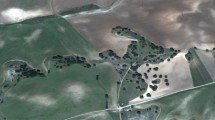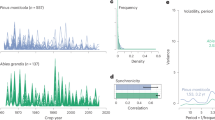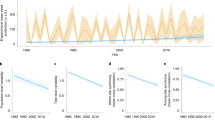Abstract
Mast-seeding is the synchronous production of large seed crops within a population or community of species every two or more years. This paper addresses three non-mutually exclusive hypotheses explaining the evolution of mast-seeding in temperate tree species, especially the genus Quercus: (1) mast-seeding is a consequence of mast-flowering which evolves to increased pollination efficiency in mast-flowering years; (2) mast-seeding has evolved as an anti-predator adaptation by which large seed crops during mast years satiate the seed predators and allow survival of some of the seeds; (3) selection on seed size by habitat can indirectly affect the evolution of masting if trees with large seeds require more time to accumulate reserves to mature those seeds. I find support for the pollination hypothesis in several wind-pollinated temperate tree species but not oaks. However, oaks show evidence favoring the predation and seed size hypotheses. I then develop a model to illustrate the relationships among the three hypotheses in their effects on the evolution of masting. Finally, using data from herbaria and Floras, the influence of selection via flowering, fruiting, and seed size in the evolution of masting in tropical oaks is discussed. I conclude that the need for a supra-annual cue to synchronize flowering and fruiting as well as the larger seed size found in many tropical oak species should contribute to the evolution of masting to a greater extent than seen among temperate oaks.
Similar content being viewed by others
References
Aizen, M. A. PattersonIII, W. A. 1990. Acorn size and geographical range in the North American oaks (Quercus L.). J. Biogeog. 17: 327–332.
Ashton, P. S., Givnish, T. J. & Appanah, S. 1988. Staggered flowering in the Dipterocarpaceae: new insights into floral induction and the evolution of masting in the aseasonal tropics. Amer. Natur. 132: 44–66.
Baker, H. G. 1972. Seed weight in relation to environmental conditions in California. Ecology 53: 997–1010.
Beaman, B. A. 1981. Factors affecting the establishment, growth, and survival of white oak (Quercus alba L.) in an upland hardwood forest. Ph. D. thesis, Duke University, Durham, NC.
Boucher, D. H. 1981. Seed predation by mammals and forest dominance by Quercus oleoides, a tropical lowland oak. Oecologia 49: 409–419.
Clark, D. A. & Clark, D. B. 1984. Spacing dynamics of a tropical rain forest tree: evaluation of the Janzen-Connell model. Amer. Natur. 124: 769–788.
De Steven, D. 1983. Reproductive consequences of insect seed predation in Hammamelis virginiana. Ecology 64: 89–98.
De Steven, D. & Putz, F. E. 1984. Impact of mammals on early recruitment of a tropical canopy tree, Dipteryx panamensis, in Panama. Oikos 43: 207–216.
Donohue, M. J. 1989. Phylogenies and the analysis of evolutionary sequences, with examples from seed plants. Evolution 43: 1137–1156.
Foster, S. A. & Janson, C. H. 1985. The relationship between seed size and establishment conditions in tropical woody plants. Ecology 66: 773–780.
Grime, J. P. & Jeffrey, D. W. 1965. Seedling establishment in vertical gradients of sunlight. J. Ecol. 53: 621–642.
Gross, K. L. 1984. Effects of seed size and growth form on seedling establishment of six monocarpic perennial plants. J. Ecol. 72: 369–387.
Janzen, D. H. 1969. Seed-eaters versus seed size, number, dispersal, and toxicity. Evolution 23: 1–27.
Janzen, D. H. 1971. Seed predation by animals. Ann. Rev. Ecol. Syst. 2: 465–492.
Janzen, D. H. 1974. Tropical blackwater rivers, animals, and mast fruiting by the Dipterocarpaceae. Biotropica 6: 69–103.
Janzen, D. H. 1978. Seeding patterns of tropical trees. In: P. B. Tomlinson and M. H. Zimmerman (eds.), Tropical trees as a living systems. Cambridge Univ. Press, New York.
Korstian, C. F. 1927. Factors controlling germination and early survival in oaks. Yale Univ. Sch. For. Bull. 19: 5–118.
Kozlowski, T. T. 1971. Growth and development of trees. Vol II. Academic Press, NY
Kozlowski, T. T. & Keller, T. 1976. Food relations of woody plants. Bot. Rev. 32: 293–382.
Loveless, L. & Hamrick, J. 1984. Ecological determinants of genetic structure in plant populations. Ann. Rev. Ecol. Syst. 15: 65–95.
Mathews, J. D. 1955. The influence of weather on the frequency of beech mast years in England. Forestry 28: 107–115.
Mazer, S. J. 1989. Ecological, taxonomic, and life history correlates of seed mass among Indiana dune angiosperms. Ecol. Monogr. 59: 153–175.
McWilliams, E. L., Landers, R. Q. & Mahlstede, J. P. 1968. Variation in seed weight and germination in populations of Amaranthus reflexus L. Ecology 49: 290–296.
Nilsson, S. G. & Wastljung, U. 1987. Seed predation and cross-pollination in mast-seedling beech (Fagus sylvatica) patches. Ecology 68: 260–265.
Norton, D. A. & Kelly, D. 1988. Mast seeding over 33 years by Dacyrdium cupressinum Lamb. (rimu) (Podocarpaceae) in New Zealand: the importance of the economies of scale. Func. Ecol. 2: 399–408.
Sarvas, R. 1952. on the flowering of birch and the quality of seed crop. Communicationes instituti Forestalis Fenniae 40: 1–35.
Sarvas, R. 1957. Studies on the seed setting of norway spruce. Meddelelser fra det Norske skogskogforsoksvesen 48: 533–556.
Sarvas, R. 1955. Investigations into the flowering and seed quality of seed crop. Communicationes Instituti Forestalis Fenniae 45: 1–37.
Schopmeyer, T. 1974. Seeds of Woody Plants in the United States. Agric. Handb. 450, U.S.D.A. For. Serv., Washington, D.C.
Shellburne, O. R. 1983. Patterns in the production, development, and maturation of acorns in Quercus alba (Fagaceae). M. S. Thesis, University of Missouri, St. Louis.
Silvertown, J. W. 1980. The evolutionary ecology of mast seeding in trees. Biol. J. Linnean Soc. 14: 235–250.
Smith, C. C. 1970. The coevolution of pine squirrels (Tamiasciurus) and conifers. Ecol. Monogr. 40: 349–371.
Smith, C. C., Hamrick, J. L. & Kramer, C. L. 1990. The advantage of mast years for wind pollination. Amer. Natur. 136: 154–166.
Sork, V. L. 1983. Mast-fruiting in hickories and availability of nuts. Amer. Midl. Natur. 109: 81–88.
Sork, V. L. 1987. Effects of predation and light on seedling establishment in Gustavia superba. Ecology 68: 1341–1350.
Sork, V. L., Sexton, O. & Bramble, J. Ecology of mast-fruiting in Missouri oaks. Ecology. (in press).
van Vredenburch, C. L. H. & la Bastide, J. G. A. 1969. The influence of meteorological factors on the cone crop of Douglas-fir in the Netherlands. Silvae Genetica 18: 182–186.
Waller, D. M. 1979. Models of mast fruiting in trees. J. Theor. Biol. 80: 223–232.
Wenger, K. F. 1957. Annual variation in the seed crops of loblolly pine. J. Forestry 55: 567–569.
Wheelwright, N. T. 1986. A seven-year study of individual variation in fruit production in tropical bird-dispersed tree species in the family Lauraceae. In: A. Estrada and T. H. Fleming (eds.), Frugivores and seed dispersal. Dr. W. Junk Pub., Dordrecht.
Winn, A. A. 1985. Effects of seed size and microsite on seedling emergence of Prunella vulgaris in four habitats. J. Ecology 73: 831–840.
Wulff, R. D. 1986. Seed size variation in Desmodium paniculatum. Il. Effects on seedling growth and physiological performance. J. Ecology 74: 99–114.
Author information
Authors and Affiliations
Rights and permissions
About this article
Cite this article
Sork, V.L. Evolutionary ecology of mast-seeding in temperate and tropical oaks (Quercus spp.). Vegetatio 107, 133–147 (1993). https://doi.org/10.1007/BF00052217
Issue Date:
DOI: https://doi.org/10.1007/BF00052217




